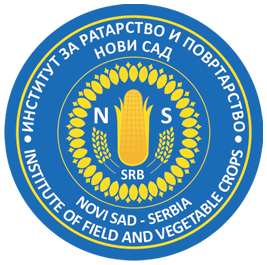Long-term cropping systems' effects on maize grain yield and yield stability in semiarid conditions
Апстракт
Knowledge of specific crop responses to crop rotation as affected by soils, climate and fertilisation is required for the selection of appropriate tillage and crop management strategies for improved crop production. In temperate regions, higher maize yield is limited to the unfavourable climatic conditions that could not be successfully compensated with the advanced cropping technology. The aim of this study was to access the maize yield stability in relation to the environmental conditions. The dataset was obtained from a long-term experiment at the Rimski Šancevi experimental station of the Institute of Field and Vegetable Crops, Novi Sad, Serbia. The study treatments were: fertilized maize 4-year crop rotation, 3-year crop rotation, 2-year crop rotation, monoculture and the unfertilized 2 and 3- year rotation. Stability analysis across diverse environmental conditions was used to understand the consistency of the performance of genotypes and agronomic management practices. The datas...et was analyzed with linear mixed model approach assuming heterogeneous trial error variances across the years. After fitting appropriate model the relationship among grain yields data and external environmental variables were modeled through the partial least squares regression in order to identify the most important variables and their relationship with treatments and years. Yield stability was attributed to efficient resource utilization and nutrient capture of newer hybrids. Higher maize yield was observed at the fertilized 2 gt 3 gt 12-year rotation, respectively, with no statistical significance. However, maize monoculture is significantly lower in yield compared to the fertilized rotation and the average yield at the unfertilized rotations is significantly lower that the fertilized one. Environmental conditions, mainly rainfall and temperature, affect the performance of the crop production systems. Our study showed that the average temperatures in June, July and August exerted higher effects on the yield of the unfertilized maize cropping systems while the precipitation in XII, I, II, VII, VIII and X-IX average were responsible for higher yield of the fertilized cropping systems. Although, results suggested that in our agroecological conditions 2-year crop rotation of maize could be recommended it is important to grow maize in the wider rotation and ensure proper crop sequence. With the overall stability of the cropping systems it will benefit the maize production as well. Our study could be useful in selection of proper cropping method in the maize production and by using advanced statistical methods to identify key constraints in adaptation of cropping management to future climatic events. © 2017 Nova Science Publishers, Inc.
Кључне речи:
Cropping systems / Grain yield / Long-term experiment / Maize / Yield stabilityИзвор:
Agricultural Research Updates, 2017, 21, 119-152Издавач:
- Nova Science Publishers, Inc.
Scopus: 2-s2.0-85044539556
Колекције
Институција/група
FiVeRTY - CHAP AU - Đalović, Ivica AU - Šeremešić, Srđan AU - Zorić, Miroslav AU - Bekavac, Goran PY - 2017 UR - http://fiver.ifvcns.rs/handle/123456789/1713 AB - Knowledge of specific crop responses to crop rotation as affected by soils, climate and fertilisation is required for the selection of appropriate tillage and crop management strategies for improved crop production. In temperate regions, higher maize yield is limited to the unfavourable climatic conditions that could not be successfully compensated with the advanced cropping technology. The aim of this study was to access the maize yield stability in relation to the environmental conditions. The dataset was obtained from a long-term experiment at the Rimski Šancevi experimental station of the Institute of Field and Vegetable Crops, Novi Sad, Serbia. The study treatments were: fertilized maize 4-year crop rotation, 3-year crop rotation, 2-year crop rotation, monoculture and the unfertilized 2 and 3- year rotation. Stability analysis across diverse environmental conditions was used to understand the consistency of the performance of genotypes and agronomic management practices. The dataset was analyzed with linear mixed model approach assuming heterogeneous trial error variances across the years. After fitting appropriate model the relationship among grain yields data and external environmental variables were modeled through the partial least squares regression in order to identify the most important variables and their relationship with treatments and years. Yield stability was attributed to efficient resource utilization and nutrient capture of newer hybrids. Higher maize yield was observed at the fertilized 2 gt 3 gt 12-year rotation, respectively, with no statistical significance. However, maize monoculture is significantly lower in yield compared to the fertilized rotation and the average yield at the unfertilized rotations is significantly lower that the fertilized one. Environmental conditions, mainly rainfall and temperature, affect the performance of the crop production systems. Our study showed that the average temperatures in June, July and August exerted higher effects on the yield of the unfertilized maize cropping systems while the precipitation in XII, I, II, VII, VIII and X-IX average were responsible for higher yield of the fertilized cropping systems. Although, results suggested that in our agroecological conditions 2-year crop rotation of maize could be recommended it is important to grow maize in the wider rotation and ensure proper crop sequence. With the overall stability of the cropping systems it will benefit the maize production as well. Our study could be useful in selection of proper cropping method in the maize production and by using advanced statistical methods to identify key constraints in adaptation of cropping management to future climatic events. © 2017 Nova Science Publishers, Inc. PB - Nova Science Publishers, Inc. T2 - Agricultural Research Updates T1 - Long-term cropping systems' effects on maize grain yield and yield stability in semiarid conditions EP - 152 SP - 119 VL - 21 UR - https://hdl.handle.net/21.15107/rcub_fiver_1713 ER -
@inbook{
author = "Đalović, Ivica and Šeremešić, Srđan and Zorić, Miroslav and Bekavac, Goran",
year = "2017",
abstract = "Knowledge of specific crop responses to crop rotation as affected by soils, climate and fertilisation is required for the selection of appropriate tillage and crop management strategies for improved crop production. In temperate regions, higher maize yield is limited to the unfavourable climatic conditions that could not be successfully compensated with the advanced cropping technology. The aim of this study was to access the maize yield stability in relation to the environmental conditions. The dataset was obtained from a long-term experiment at the Rimski Šancevi experimental station of the Institute of Field and Vegetable Crops, Novi Sad, Serbia. The study treatments were: fertilized maize 4-year crop rotation, 3-year crop rotation, 2-year crop rotation, monoculture and the unfertilized 2 and 3- year rotation. Stability analysis across diverse environmental conditions was used to understand the consistency of the performance of genotypes and agronomic management practices. The dataset was analyzed with linear mixed model approach assuming heterogeneous trial error variances across the years. After fitting appropriate model the relationship among grain yields data and external environmental variables were modeled through the partial least squares regression in order to identify the most important variables and their relationship with treatments and years. Yield stability was attributed to efficient resource utilization and nutrient capture of newer hybrids. Higher maize yield was observed at the fertilized 2 gt 3 gt 12-year rotation, respectively, with no statistical significance. However, maize monoculture is significantly lower in yield compared to the fertilized rotation and the average yield at the unfertilized rotations is significantly lower that the fertilized one. Environmental conditions, mainly rainfall and temperature, affect the performance of the crop production systems. Our study showed that the average temperatures in June, July and August exerted higher effects on the yield of the unfertilized maize cropping systems while the precipitation in XII, I, II, VII, VIII and X-IX average were responsible for higher yield of the fertilized cropping systems. Although, results suggested that in our agroecological conditions 2-year crop rotation of maize could be recommended it is important to grow maize in the wider rotation and ensure proper crop sequence. With the overall stability of the cropping systems it will benefit the maize production as well. Our study could be useful in selection of proper cropping method in the maize production and by using advanced statistical methods to identify key constraints in adaptation of cropping management to future climatic events. © 2017 Nova Science Publishers, Inc.",
publisher = "Nova Science Publishers, Inc.",
journal = "Agricultural Research Updates",
booktitle = "Long-term cropping systems' effects on maize grain yield and yield stability in semiarid conditions",
pages = "152-119",
volume = "21",
url = "https://hdl.handle.net/21.15107/rcub_fiver_1713"
}
Đalović, I., Šeremešić, S., Zorić, M.,& Bekavac, G.. (2017). Long-term cropping systems' effects on maize grain yield and yield stability in semiarid conditions. in Agricultural Research Updates Nova Science Publishers, Inc.., 21, 119-152. https://hdl.handle.net/21.15107/rcub_fiver_1713
Đalović I, Šeremešić S, Zorić M, Bekavac G. Long-term cropping systems' effects on maize grain yield and yield stability in semiarid conditions. in Agricultural Research Updates. 2017;21:119-152. https://hdl.handle.net/21.15107/rcub_fiver_1713 .
Đalović, Ivica, Šeremešić, Srđan, Zorić, Miroslav, Bekavac, Goran, "Long-term cropping systems' effects on maize grain yield and yield stability in semiarid conditions" in Agricultural Research Updates, 21 (2017):119-152, https://hdl.handle.net/21.15107/rcub_fiver_1713 .



